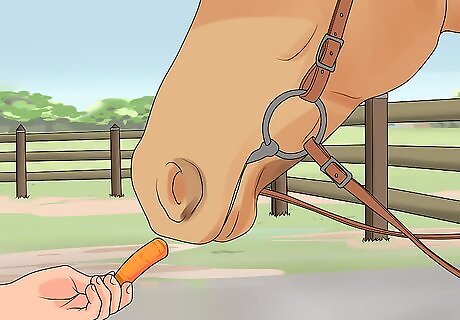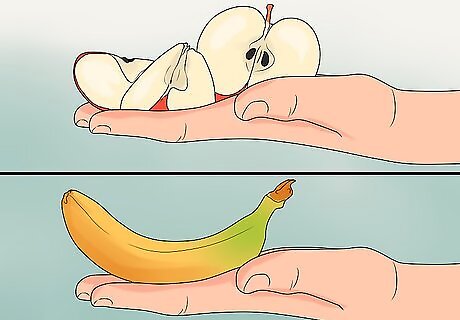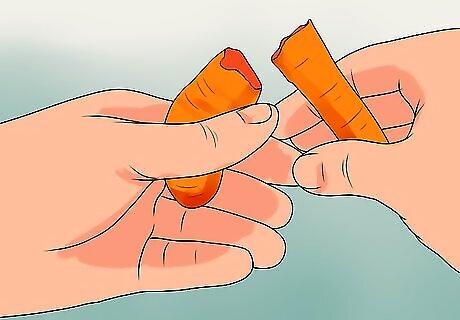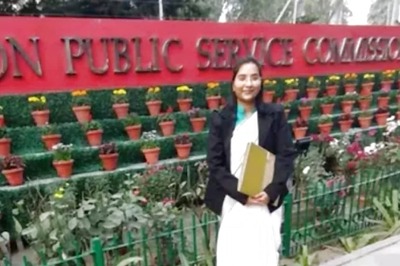
views
Feeding a Horse Treats

Give treats in moderation. Both in terms of frequency and amount, always limit the amount of treats you feed your horse. There are several important reasons to keep portions of treats small, many of which have to do with horse digestion. Your horse’s digestive tract contains a balance of bacteria and microbes that are vital to healthy intestinal function. This balance is actually quite fragile, and too much of even a healthy treat can upset a horse’s digestive track, leading to discomfort, colic, or other illnesses. Feed your horse only one or two carrots at a time. Small portions of treats are vital. Aside from digestive issues, avoid messing with your horse’s diet, as this risks lowering protein absorption and diluting vitamin and mineral amounts.

Don’t let treats encourage bad behavior. If your horse starts to anticipate receiving treats, this will likely negatively affect their behavior. Even the well-intended use of treats for training risks reinforcing bad behavior. Accordingly, you should: Never feed another person’s horse a treat without permission. Never feed a treat to a horse that is in a pen with other horses. Don’t ever feed a horse a treat “just because”. Learn and follow a protocol on how to give treats to positively reinforce good behavior only.

Use treats to reinforce positive behavior. The good news is that treats can be used to effectively encourage good behavior. However, you must balance the use of treats to influence behavior by ensuring your horse does not come to expect treats. Employ a diminishing reward system. Reduce the frequency and portion of treats as a good behavior becomes a conditioned response. Instead of treats, slowly transfer to friendly stroking and positive verbal encouragement following a desired behavior. Only use treats intermittently in training regimes. Not everything you teach your horse needs to incorporate treats.

Be consistent with your delivery and timing of treats. Training, especially training with treats, depends on your consistent delivery of reinforcement and the clarity of the message you’re sending to your horse. One way to articulate your pleasure with positive behavior is to establish a word or short phrase, such as “good horse”. Always accompany this phrase with affectionate touching and a positive tone of voice. Use this phrase as a bridge signal to let your horse know they have earned a treat. Only give a treat within three seconds of a bridge signal, which should immediately follow a behavior you are trying to reinforce. The sequence you employ when giving treats must always stay the same.

Feed your horse treats correctly. While you can feed a horse by bucket, trough, or hand, there are risks involved in feeding a horse by hand. Horses fed by hand are more likely to get nippy with you and others. Of course, to properly use treats as a training tool, you must feed your horse treats by hand. If you do feed a horse a treat by hand, it’s important to do so correctly. Place a piece of carrot in the palm of your hand, with the fingers lying as flat as you can get them. That way, the horse will be less likely to accidentally bite you. Hold your hand out in front of you, where the horse can easily see it. As the horse reaches for the treat, gently and slowly raise your hand towards the horse’s mouth. Don’t withdraw your hand at the last second, as this may cause the horse to lunge for the treat and potentially chomp your hand. Do not carry treats in your pocket. Some horses will nip at your clothes if they know there are treats in them. This can end badly for all parties. Horses will generally only take bites that are small enough to chew. However, if you'd like, you can cut the carrot into smaller pieces.
Incorporating Treats into Your Horse’s Diet

Give your horse only healthy treats. Aside from carrots, other classics include apple slices and bananas. There are actually lots of fruits and vegetables that are safe for horses. Other fruits horses love include: Apricots, blackberries, blueberries, cherries, dates, figs, grapes (and raisins), grapefruit, mangoes, oranges, peaches, pears, pineapple, plums, strawberries, tangerines, and watermelon. Whenever you feed a horse anything that has a pit, remove the pit first. Other safe snacks include: Beets, celery, corn, horseradish, lettuce, pumpkin, rutabaga, squash, sweet potatoes, and turnips.

Break carrots and other treats into small pieces. Some horses will get especially excited by treats and try to gulp them down. They may even swallow with such voracity that they wind up choking. Break up carrots with your hands or cut them into small pieces.

Make homemade horse treats! Include carrots and oatmeal in a recipe for cookies designed specifically for horses. Start by mixing 1 cup uncooked oatmeal, 1 cup flour, and 1 cup shredded carrots. Stir in 1 teaspoon salt, 1 tablespoon sugar, 2 tablespoons corn oil, a ¼ cup water, and a ¼ cup molasses. Roll dough into small balls and place them on a greased cookie sheet. Bake horse cookies at 350 degrees for 15 minutes or until golden brown.

Balance treats with a horse’s regular diet. A horse’s diet should regularly consist of plenty of roughage, as well as grain. Feed your horse a consistent diet with disciplined regularity. Ensure a horse eats one to two percent of their body weight in roughage every day. A horse’s digestive system is designed to eat grassy stalks, such as hay. This should make up the majority of your horse’s diet. Allow your horse to replicate the eating pattern associated with foraging by simply making roughage available all day. Provide grain in small amounts, twice a day. Not only are smaller meals more natural, they allow for better digestion. Some people also feed their horses a third time at noon. Feed according to size, lifestyle, and season. If your horse is at pasture all day, you don’t need to provide hay. Winter weather may prevent the availability of grass, however, necessitating the provision of hay. (In the spring and summer, there will likely be plenty of grass naturally available to your horse if they have sufficient pasture.) Make any dietary changes slowly and intermittently. Do not make any sudden or drastic changes to your horse’s diet. If you’re changing a type of feed, only replace ¼ of a batch with the new food every other day until the new food has fully replaced the old. Always consult your vet if you aren't sure about your horse's feeding schedule.

Don’t feed your horse unsafe snacks. Even sugar cubes, which are frequently used as snacks, are pretty unhealthy for horses (though they’re not dangerous, they’re simply a bit gratuitous in the sugar department). More importantly, there are certain things you be sure never to feed your horse. Don’t allow your horse to eat lawn clippings. There may be poisonous plants or pieces of yard debris in clippings that might cause your horse to choke. Certain lawn clippings can also cause dramatic changes to your horse’s digestive tract, causing illness or discomfort. Be careful about cabbage, broccoli, and cauliflower. These plants can all cause bloating, gas, and discomfort if your horse eats a lot of them. Avoid potatoes and tomatoes. While some claim these are fine, it’s best to avoid them as they’re members of the nightshade family of plants, some of which are poisonous to horses. Accordingly, also avoid feeding your horse any type of pepper. Do not feed your horse chocolate. While there’s not immediate danger, chocolate can cause positive results on drug tests (if your horse competes). Avoid bready items. Bread products, especially fresh bread and donuts can turn into a clump of dough in the digestive tract and block your horse’s bowels. Nobody wants that. Skip the sweet feed. Even some foods meant for horses can risk an unbalanced diet. While meant to be fed as treats, there are simply healthier options. Other specific foods that are unsafe for your horse include avocado, onions, persimmons, and rhubarb.
















Comments
0 comment